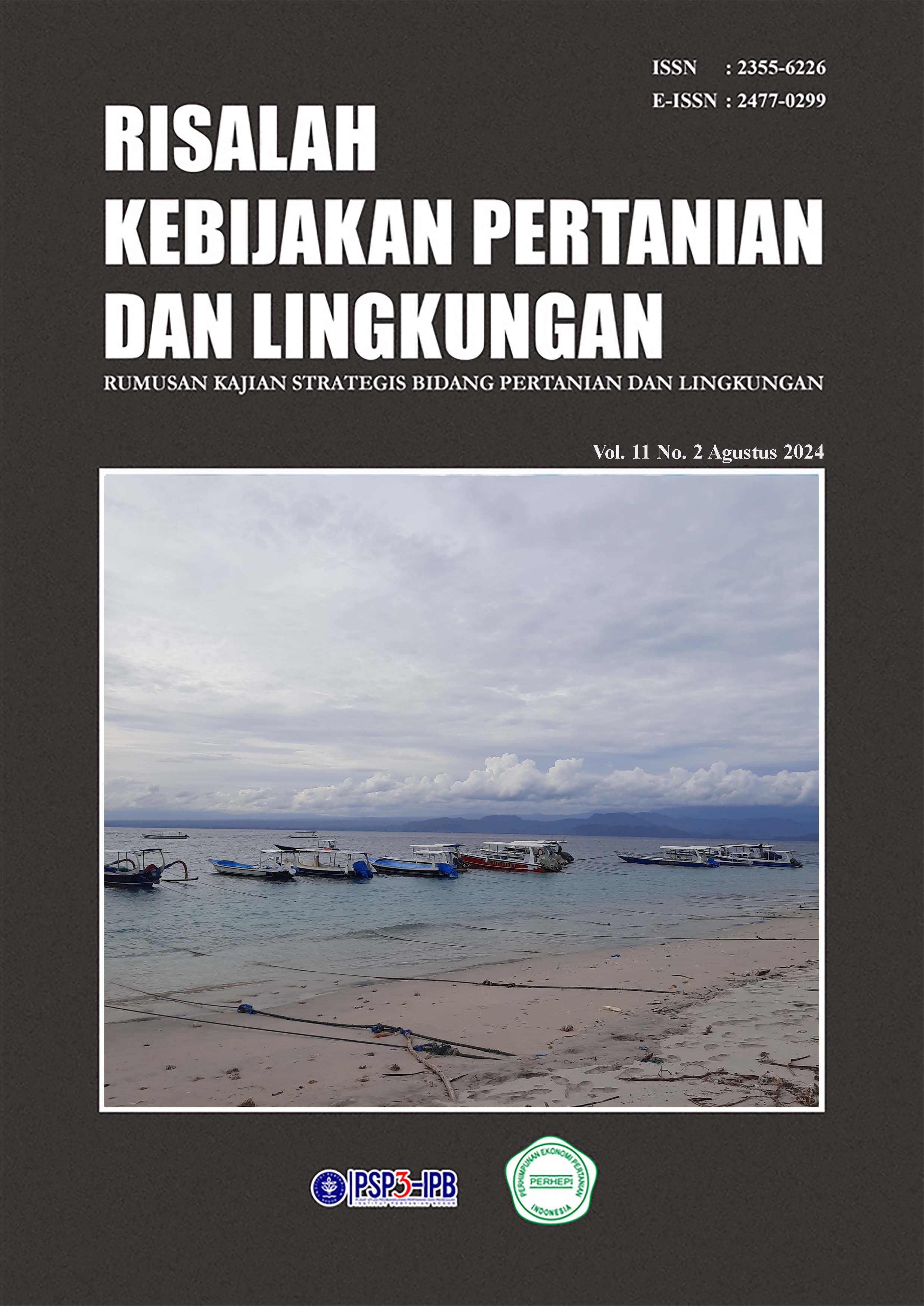DESAIN REGULASI SPASIAL LANSKAP LAHAN PERTANIAN UNTUK KEMANDIRIAN PANGAN KABUPATEN MAJALENGKA HINGGA TAHUN 2045
Abstract
The conversion of agricultural land into built-up land is one of the factors causing the decline in rice production in Majalengka Regency and West Java Province. The agricultural sector still plays a vital role in local economic development, as evidenced by the GRDP of the agriculture, forestry, and fisheries sector being the second highest after the processing industry. Regional Regulation No. 11 of 2011 regarding the Spatial Planning of Majalengka Regency 2011-2031 stipulates a minimum of 39,190 ha of sustainable agricultural land. However, this amount has decreased to 30,966 ha with the issuance of Majalengka Regent Decree No. 520/KEP.1279-DKP3/2021 on the Designation of Sustainable Agricultural Land. To mitigate the negative impact of the reduction in land area, policy formulations supporting the preservation of agricultural land and implementing sustainable farming practices by local governments and related stakeholders are necessary. These efforts aim to maintain the area of food agricultural land within the framework of achieving food self-sufficiency in the Majalengka Regency. The study shows that to meet food (rice) needs until 2045, according to the direction of the RPJPN Development, a protected rice field area of 48,235 ha is required, with a surplus of 4,037 tons of rice.
Metrics
Downloads
References
Adrian, Widiatmaka, Munibah K, Firmansyah I, Adrian. 2024. Enhancing agricultural protection areas under spatial restrictions: A case study of Majalengka Regency, Indonesia. Geography, Environment, Sustainability. 17(1): 67–82. DOI: https://doi.org/10.24057/2071-9388-2023-2939
Adrian, Widiatmaka, Munibah K, Firmansyah I. 2022. Evaluate land suitability analysis for rice cultivation using a GIS-based AHP multi-criteria decision-making approach: Majalengka Regency, West Java Province. IOP Conference Series: Earth and Environmental Science. 1109. doi: 10.1088/1755-1315/1109/1/012062. DOI: https://doi.org/10.1088/1755-1315/1109/1/012062
Arifin HS, Munandar A, Nurhayati HSA, Kaswanto RL. 2009. Potensi Kegiatan Agrowisata di Perdesaan (Buku Seri IV: Manajemen Lanskap Perdesaan bagi Kelestarian dan Kesejahteraan Lingkungan). Kementerian Pertanian Republik Indonesia.
Bondansari B, Widiatmaka W, Machfud M, Munibah K, Ambarwulan W. 2024. Kebijakan Menuju Kemandirian Beras, Kasus di Kabupaten Banyumas Jawa Tengah. Risalah Kebijakan Pertanian dan Lingkungan Rumusan Kajian Strategis Bidang Pertanian dan Lingkungan. 11(1): 33-45. doi: 10.29244/jkebijakan.v11i1.53470. DOI: https://doi.org/10.29244/jkebijakan.v11i1.53470
Budiman VP, Nurhayati HSA, Arifin HS, Astawan M, Kaswanto RL. 2013. Optimalisasi Fungsi Pekarangan Melalui Program Percepatan Penganekaragaman Konsumsi Pangan (P2KP) di Kabupaten Bogor, Jawa Barat. Prosiding Lokakarya Nasional dan Seminar FKPTPI, Bogor, 2-4
Dasanto, BD, Sulistiyanti S, Anria A, Boer R. 2022. Dampak perubahan iklim terhadap kenaikan muka air laut di Wilayah Pesisir Pangandaran. Risalah Kebijakan Pertanian dan Lingkungan Rumusan Kajian Strategis Bidang Pertanian dan Lingkungan. 9(2): 82-94. doi: 10.29244/jkebijakan.v9i2.28039. DOI: https://doi.org/10.29244/jkebijakan.v9i2.28039
Faradilla E, Kaswanto RL, Arifin HS. 2018. Analisis kesesuaian lahan untuk ruang terbuka hijau dan ruang terbuka biru di Sentul City, Bogor. Jurnal Lanskap Indonesia. 9(2): 101-109. doi: 10.29244/jli.v9i2.17398. DOI: https://doi.org/10.29244/jli.v9i2.17398
Firnawati F, Kaswanto RL, Sjaf S. 2021. Pemetaan partisipatif potensi jasa lanskap kawasan hutan Desa Pattaneteang, Kabupaten Bantaeng. Jurnal Pengelolaan Sumberdaya Alam dan Lingkungan (Journal of Natural Resources and Environmental Management). 11(2): 189-203. doi: 10.29244/jpsl.11.2.189-203. DOI: https://doi.org/10.29244/jpsl.11.2.189-203
Hernawati H. 2021. Analisis efisiensi teknis usahatani padi lahan irigasi di Kabupaten Lombok Barat. Risalah Kebijakan Pertanian dan Lingkungan Rumusan Kajian Strategis Bidang Pertanian dan Lingkungan. 8(2): 87-91. doi: 10.29244/jkebijakan.v8i2.28037. DOI: https://doi.org/10.29244/jkebijakan.v8i2.28037
Jiang P, Cheng Q, Zhuang Z, Tang H, Li M, Cheng L, Jin X. 2018. The dynamic mechanism of landscape structure change of arable landscape system in China. Agriculture, Ecosystems and Environment. 251: 26–36. doi: 10.1016/j.agee.2017.09.006. DOI: https://doi.org/10.1016/j.agee.2017.09.006
Jiang P, Li M, Sheng Y. 2020. Spatial regulation design of farmland landscape around cities in China: A case study of Changzhou City. Cities, 97. doi: 10.1016/j.cities.2019.102504. DOI: https://doi.org/10.1016/j.cities.2019.102504
Kaswanto RL, Aurora RM, Yusri D, Sjaf S, Barus S. 2021a. Kesesuaian lahan untuk komoditas unggulan pertanian di Kabupaten Labuhanbatu Utara. Analisis Kebijakan Pertanian. 19(2): 189-205. doi: 10.21082/akp.v19n2.2021.189-205. DOI: https://doi.org/10.21082/akp.v19n2.2021.189-205
Kaswanto RL, Aurora RM, Yusri D, Sjaf S. 2021b. Analisis faktor pendorong perubahan tutupan lahan selama satu dekade di Kabupaten Labuhanbatu Utara. Jurnal Ilmu Lingkungan. 19(1): doi: 107-116. 10.14710/jil.19.1.107-116. DOI: https://doi.org/10.14710/jil.19.1.107-116
Liang, C, Penghui, J, Wei C, Manchun L, Liyan W, Yuan G, Yuzhe P, Nan X, Yuewei D, Qiuhao H. 2015. Farmland protection policies and rapid urbanization in China: A case study for Changzhou City. Land Use Policy. 48: 552–566. doi: 10.1016/j.landusepol.2015.06.014. DOI: https://doi.org/10.1016/j.landusepol.2015.06.014
Maurya MK, Sarma A, Tamuly G, Shukla V K, Behera P, Bora SS, Chakravarthi, B. 2023. Rice ratooning: A pioneering strategy for enhancing rice productivity and embracing climate change adaptation and mitigation. International Journal of Plant & Soil Science. 35(20): 1047–1059. DOI: https://doi.org/10.9734/ijpss/2023/v35i203900
Munibah K, Sitorus SRP, Rustiadi E, Gandasasmita K, Hartrisari H. 2019. Model hubungan antara jumlah penduduk dengan luas lahan pertanian dan permukiman (Studi Kasus DAS Cidanau, Provinsi Banten). Jurnal Ilmu Tanah Dan Lingkungan. 11(1): 32–40. doi: 10.29244/jitl.11.1.32-40 DOI: https://doi.org/10.29244/jitl.11.1.32-40
Qisthina N, Kaswanto RL, Arifin HS. 2023. Analysis of land cover change impacts on landscape services quality in Cisadane Watershed, Tangerang City. In IOP Conference Series: Earth and Environmental Science 1133(1). IOP Publishing. DOI: https://doi.org/10.1088/1755-1315/1133/1/012051
Rozi F, Santoso AB, Mahendri IGAP, Hutapea RTP, Wamaer D, Siagian V, Elisabeth DAA, Sugiono S, Handoko H, Subagio H, Syam A. 2023. Indonesian market demand patterns for food commodity sources of carbohydrates in facing the global food crisis. Heliyon. 9(6). doi: 10.1016/j.heliyon.2023.e16809. DOI: https://doi.org/10.1016/j.heliyon.2023.e16809
Rustiadi E. 1997. Alih Fungsi Lahan Dalam Perspektif. Lokakarya Penyusunann Kebijakan Dan Strategi Pengelolaan Lingkungan Kawasan Perdesaan, September 2015.
Wihardjaka A, Pramono A, Sutriadi MT. 2020. Peningkatan produktivitas padi sawah tadah hujan melalui penerapan teknologi adaptif dampak perubahan iklim. Jurnal Sumberdaya Lahan. 14(1): 25-36. DOI: https://doi.org/10.21082/jsdl.v14n1.2020.25-36
Zhuang Y, Liu H, Zhang L, Li S. 2020. Research perspectives on paddy field systems: ecological functions and environmental impacts. International Journal of Agricultural Sustainability, 18(6): 505–520. DOI: https://doi.org/10.1080/14735903.2020.1793652
Copyright (c) 2024 RISALAH KEBIJAKAN PERTANIAN DAN LINGKUNGAN: Rumusan Kajian Strategis Bidang Pertanian dan Lingkungan

This work is licensed under a Creative Commons Attribution 4.0 International License.
PUBLICATION ETHICS
Jurnal Risalah Kebijakan Pembangunan Pertanian dan Lingkungan (JRKPL) is a peer-reviewed journal publishing original research to develop a coherent and respected network of landscape architecture knowledge. JRKPL committed to upholding the highest standards of publication ethics that clarifies ethical behavior of all parties involved in publishing a scientific article in JRKPL.
As publisher of JRKPL, PSP3-LPPM IPB and PERHEPI takes its duties of guardianship all stages of publishing process and we recognize our ethical and other responsibilities.
Duties of Authors
An author should not publish manuscripts describing essentially the same research in more than one journal or primary publication. Submitting the same manuscript to more than one journal is unacceptable and constitutes unethical publishing behavior. In general, an author should not submit for consideration in another journal a previously published paper.
Authorship should be limited to those who have made a significant contribution to the manuscript and should be listed as co-authors. Where there are others who have participated in certain substantive aspects of the research project, they should be acknowledged as contributors. The corresponding author should ensure that all co-authors have seen and approved the final version of the paper and have agreed to its submission for publication.
The authors should ensure that they have written entirely original works, and if the authors have used the work and/or words of others, that this has been appropriately cited or quoted. Plagiarism are include passing off another paper as the author own paper, copying or paraphrasing substantial parts of another paper (without attribution) and claiming results from research conducted by others. Plagiarism constitutes unethical publishing behavior and is unacceptable. Plagiarism detected works will be banned for further publication procedure.
The authors acknowledge that they have disclosed all and any actual or potential conflicts of interest with their work or partial benefits associated with it. All sources of financial support for the project should be disclosed. Potential conflicts of interest should be disclosed at the earliest stage possible.
Duties of the Editorial Board
Review Process
JRKPL is committed to objective and fair double-blind peer-review to prevent any actual or potential conflict of interests between the editorial and review personnel and the reviewed material. JRKPL chooses reviewers based on their expertise (whose most closely matches the topic of the paper). At least 2 reviewers are invited to evaluate a manuscript. In cases of controversy or disagreement regarding the merits of the work, an additional review will be solicited. The JRKPL editor mediates all interaction between authors and reviewers, and the review results owned by JRKPL.
Publication Decisions
The editor of a peer-reviewed JRKPL is responsible for deciding which of the articles submitted to the journal should be published. The validation of the work in question and its importance to researchers and readers must always drive such decisions. The final decision on article acceptance based on reviewer's opinions, suggestions, and comments. The editor may confer with other editors or reviewers in making this decision.
Fair Play
JRKPL evaluates manuscripts only based on the intellectual content. No race, gender, sexual orientation, religious belief, ethnic origin, citizenship, or political philosophies of the authors are considered in the evaluation process.
Confidentiality
JRKPL assure the confidentially of the manuscripts, actors, and other related information on the publishing process. Only corresponding author, reviewers, potential reviewers, other editorial advisers, and the publisher are allows for the information.
Disclosure
Unpublished materials disclosed in a submitted manuscript must not be used in an editor's own research without the express written consent of the author. Privileged information or ideas obtained through peer review must be kept confidential and not used for personal advantage.
Duties of reviewers
(1) Objectivity: Reviewer should provide written and unbiased feedback to the authors, personal criticism of the author is inappropriate. Reviewer comments should be clearly with supporting arguments indicating whether the writing is concise and relevant
(2) Expertise: Reviewer who feels unqualified to review the research reported in a manuscript or knows that its prompt review will be impossible should notify the editor and excuse himself from the review process.
(3) Acknowledgement of sources: Reviewer suggest relevant published work that has not been cited by the authors to improve the quality of the manuscript,
(4) Confidentiality: Reviewer should maintain the confidentiality of the review process. Privileged information or ideas obtained through peer review must be kept confidential and not used for personal advantage.
(5) Disclosure and conflict of interest: Unpublished materials disclosed in a submitted manuscript must not be used in a reviewer own research without the express written consent of the author. Reviewers should not consider manuscripts in which they have conflicts of interest resulting from competitive, collaborative, or other relationships or connections with any of the authors, companies, or institutions connected to the papers.























